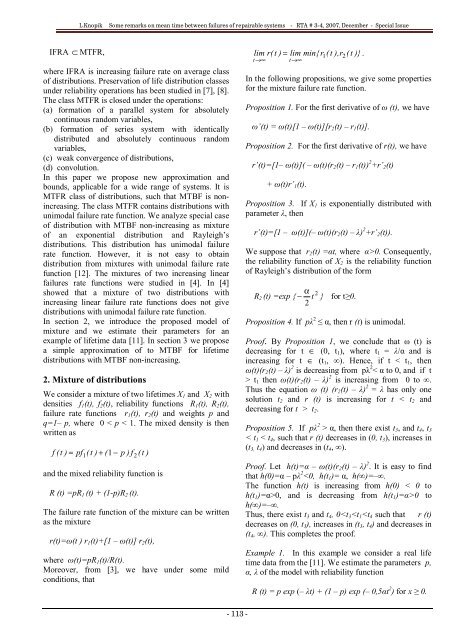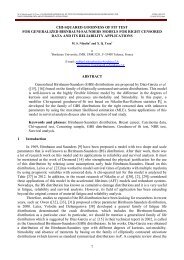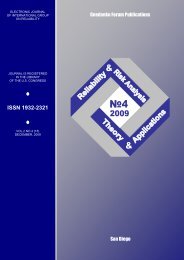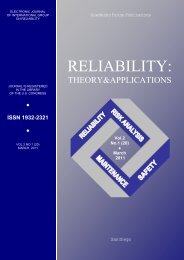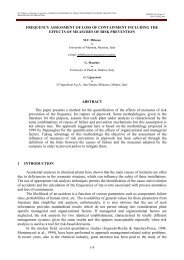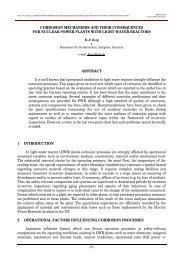Full Text in PDF - Gnedenko e-Forum
Full Text in PDF - Gnedenko e-Forum
Full Text in PDF - Gnedenko e-Forum
Create successful ePaper yourself
Turn your PDF publications into a flip-book with our unique Google optimized e-Paper software.
L.Knopik Some remarks on mean time between failures of repairable systems - RTA # 3-4, 2007, December - Special IssueIFRA ⊂ MTFR,where IFRA is <strong>in</strong>creas<strong>in</strong>g failure rate on average classof distributions. Preservation of life distribution classesunder reliability operations has been studied <strong>in</strong> [7], [8].The class MTFR is closed under the operations:(a) formation of a parallel system for absolutelycont<strong>in</strong>uous random variables,(b) formation of series system with identicallydistributed and absolutely cont<strong>in</strong>uous randomvariables,(c) weak convergence of distributions,(d) convolution.In this paper we propose new approximation andbounds, applicable for a wide range of systems. It isMTFR class of distributions, such that MTBF is non<strong>in</strong>creas<strong>in</strong>g.The class MTFR conta<strong>in</strong>s distributions withunimodal failure rate function. We analyze special caseof distribution with MTBF non-<strong>in</strong>creas<strong>in</strong>g as mixtureof an exponential distribution and Rayleigh’sdistributions. This distribution has unimodal failurerate function. However, it is not easy to obta<strong>in</strong>distribution from mixtures with unimodal failure ratefunction [12]. The mixtures of two <strong>in</strong>creas<strong>in</strong>g l<strong>in</strong>earfailures rate functions were studied <strong>in</strong> [4]. In [4]showed that a mixture of two distributions with<strong>in</strong>creas<strong>in</strong>g l<strong>in</strong>ear failure rate functions does not givedistributions with unimodal failure rate function.In section 2, we <strong>in</strong>troduce the proposed model ofmixture and we estimate their parameters for anexample of lifetime data [11]. In section 3 we proposea simple approximation of to MTBF for lifetimedistributions with MTBF non-<strong>in</strong>creas<strong>in</strong>g.2. Mixture of distributionsWe consider a mixture of two lifetimes X 1 and X 2 withdensities f 1 (t), f 2 (t), reliability functions R 1 (t), R 2 (t),failure rate functions r 1 (t), r 2 (t) and weights p andq=1– p, where 0 < p < 1. The mixed density is thenwritten asf (t ) = pf1( t ) + ( 1 − p ) f 2(t)and the mixed reliability function isR (t) =pR 1 (t) + (1-p)R 2 (t).The failure rate function of the mixture can be writtenas the mixturer(t)=(t ) r 1 (t)+[1 – (t)] r 2 (t),where (t)=pR 1 (t)/R(t).Moreover, from [3], we have under some mildconditions, thatlim r( t ) = lim m<strong>in</strong>{ r ( t ),r ( t )} .t→∞t→∞1In the follow<strong>in</strong>g propositions, we give some propertiesfor the mixture failure rate function.Proposition 1. For the first derivative of (t), we have’(t) = (t)[1 – (t)][r 2 (t) – r 1 (t)].Proposition 2. For the first derivative of r(t), we haver’(t)=[1– (t)]( – (t)(r 2 (t) – r 1 (t)) 2 +r’ 2 (t)+ (t)r’ 1 (t).Proposition 3. If X 1 is exponentially distributed withparameter , thenr’(t)=[1 – (t)](– (t)(r 2 (t) – ) 2 +r’ 2 (t)).We suppose that r 2 (t) =t, where >0. Consequently,the reliability function of X 2 is the reliability functionof Rayleigh’s distribution of the formαR 2 (t) =exp { − t 2 }22for t0.Proposition 4. If 2 , then r (t) is unimodal.Proof. By Proposition 1, we conclude that (t) isdecreas<strong>in</strong>g for t ∈ (0, t 1 ), where t 1 = and is<strong>in</strong>creas<strong>in</strong>g for t ∈ (t 1 , ). Hence, if t < t 1 , then(t)(r 2 (t) – ) 2 is decreas<strong>in</strong>g from p 2 < to 0, and if t> t 1 then (t)(r 2 (t) – ) 2 is <strong>in</strong>creas<strong>in</strong>g from 0 to .Thus the equation (t) (r 2 (t) – ) 2 = has only onesolution t 2 and r (t) is <strong>in</strong>creas<strong>in</strong>g for t < t 2 anddecreas<strong>in</strong>g for t > t 2 .Proposition 5. If 2 > , then there exist t 3 , and t 4 , t 3< t 1 < t 4 , such that r (t) decreases <strong>in</strong> (0, t 3 ), <strong>in</strong>creases <strong>in</strong>(t 3, t 4 ) and decreases <strong>in</strong> (t 4 , ).Proof. Let h(t)= – (t)(r 2 (t) – ) 2 . It is easy to f<strong>in</strong>dthat h(0)= – p 2 0, and is decreas<strong>in</strong>g from h(t 1 )=>0 toh()=–.Thus, there exist t 3 and t 4 , 0


